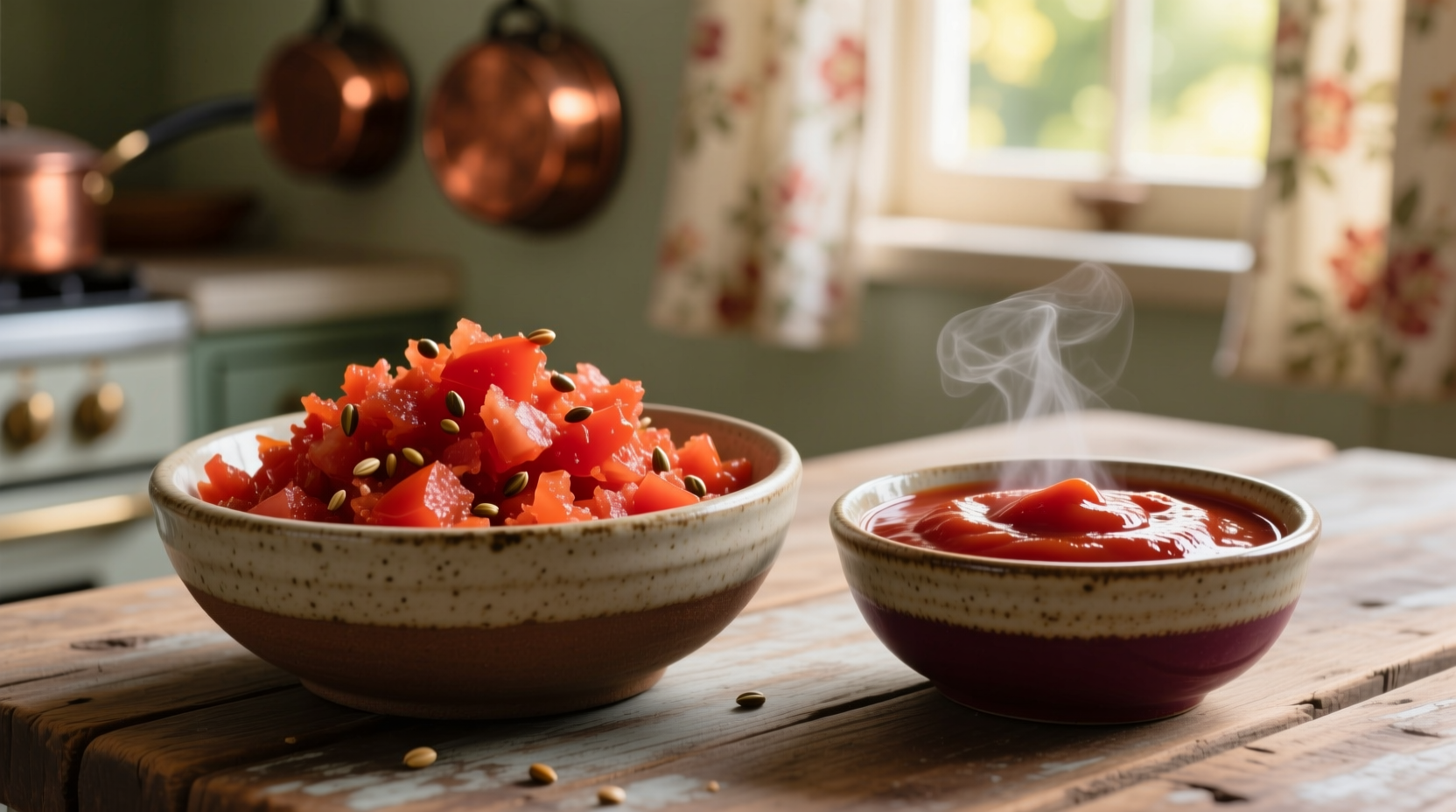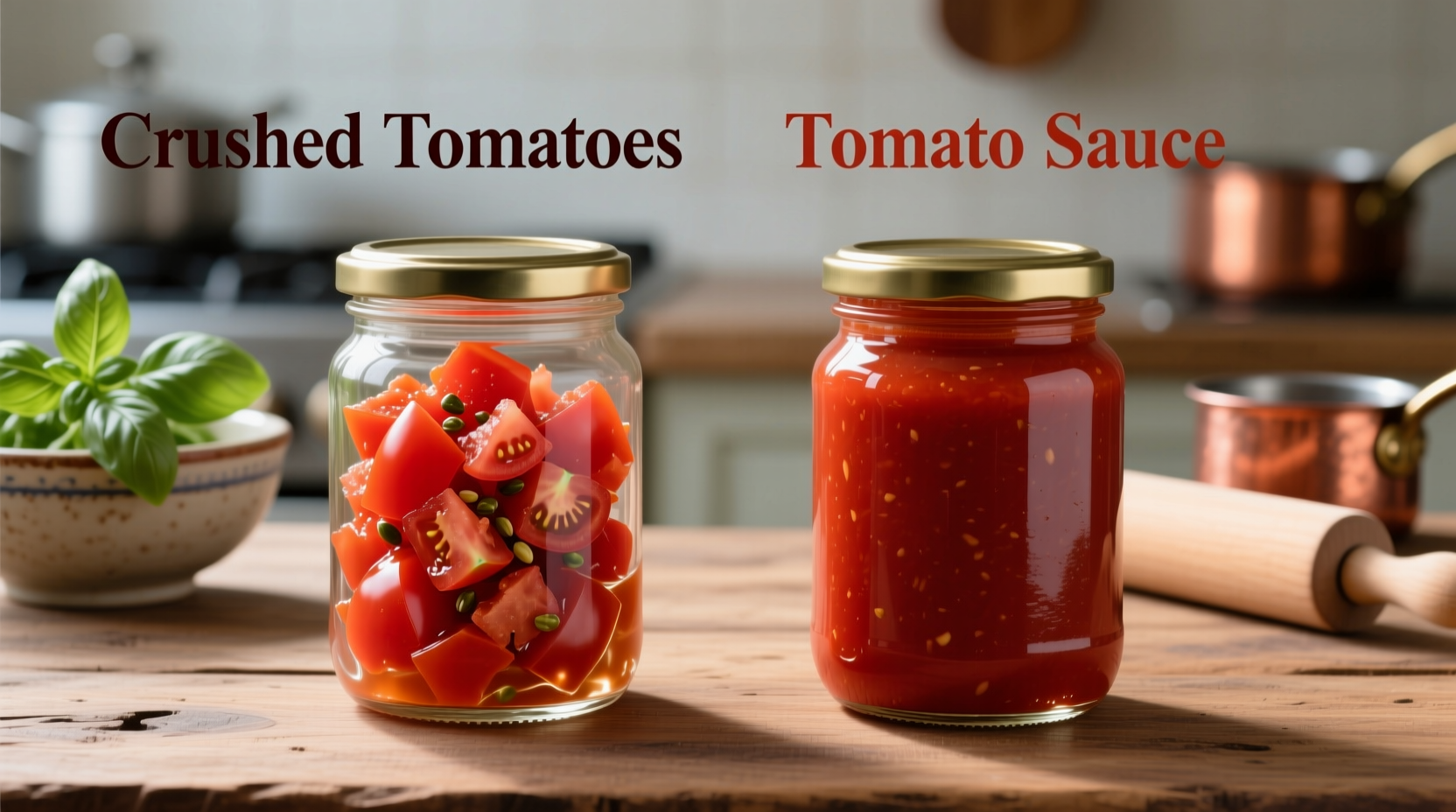Ever stood confused in the canned tomato aisle wondering whether to grab crushed tomatoes or tomato sauce for your recipe? You're not alone. Understanding the crushed tomatoes vs tomato sauce difference prevents recipe disasters and elevates your cooking. This guide cuts through the confusion with science-backed comparisons, practical substitution tips, and chef-tested usage guidelines—so you'll never second-guess your tomato selection again.
What Exactly Sets Crushed Tomatoes and Tomato Sauce Apart?
At first glance, these canned tomato products seem interchangeable. But their processing methods create distinct culinary properties that significantly impact your dishes. Let's examine the core differences that matter most in your kitchen.
| Characteristic | Crushed Tomatoes | Tomato Sauce |
|---|---|---|
| Texture | Chunky pieces in liquid | Smooth, uniform consistency |
| Processing | Tomatoes crushed but not pureed | Cooked, strained, and often seasoned |
| Thickness | Medium-thick with visible texture | Thin to medium, pourable consistency |
| Added Ingredients | Minimal (citric acid, calcium chloride) | Often includes herbs, spices, sugar |
| Typical Use | Chunky sauces, soups, stews | Smooth sauces, braises, as base ingredient |
Texture and Consistency: Why It Matters in Your Cooking
The most critical difference between crushed tomatoes and tomato sauce lies in texture. Crushed tomatoes maintain recognizable tomato pieces suspended in liquid, creating a rustic, hearty mouthfeel. This texture holds up well in long-cooking dishes like chili or hearty pasta sauces where you want distinct tomato elements.
Tomato sauce undergoes additional processing—it's cooked, strained, and often seasoned—resulting in a smooth, uniform consistency. This makes it ideal when you need a seamless base that won't compete with other ingredients. According to the USDA's Food Processing Handbook, tomato sauce typically has a Brix level (sugar content) of 8-12%, while crushed tomatoes range from 4-6%, affecting both flavor and cooking behavior.

When to Choose Crushed Tomatoes: Optimal Applications
Reach for crushed tomatoes when your recipe benefits from:
- Chunky texture - Perfect for rustic pasta sauces, minestrone soup, or shakshuka where tomato pieces should remain distinct
- Shorter cooking times - Their rawer state allows flavors to develop during cooking
- Acid balance - Contains natural acids that help maintain structure in quick-cooked dishes
- DIY customization - Start with a neutral base you can season exactly to your preference
Chef Thomas Keller's Ad Hoc at Home cookbook specifically calls for crushed tomatoes in his Sunday gravy recipe because "the texture provides body without requiring lengthy reduction."
When Tomato Sauce Shines: Ideal Culinary Uses
Tomato sauce excels in applications requiring:
- Smooth consistency - Essential for velouté-style sauces, pizza bases, or dishes where uniform texture matters
- Time savings - Already partially cooked, reducing overall preparation time
- Flavor foundation - Many varieties include herbs and seasonings that build complex flavor bases
- Binding properties - Works better in casseroles or baked dishes where separation would be problematic
The Food and Drug Administration's Standards of Identity (21 CFR § 155.191) specifies that commercial tomato sauce must be strained to remove seeds and skins, explaining its smooth texture compared to crushed tomatoes which retain more particulate matter.
Substitution Guide: Making the Switch Without Ruining Your Dish
Running out of one product? These crushed tomatoes and tomato sauce substitution guidelines prevent kitchen emergencies:
- Crushed tomatoes → Tomato sauce: Blend 1 cup crushed tomatoes with 2 tbsp water until smooth. Simmer 5-7 minutes to cook out raw flavor.
- Tomato sauce → Crushed tomatoes: Simmer 1 cup tomato sauce with ½ cup diced fresh tomatoes for 10 minutes to restore texture.
- Emergency swap: Use tomato paste diluted with water (1:2 ratio) when neither option is available.
Remember: Substitutions work best in forgiving dishes like soups or stews. For delicate sauces or baking applications, using the specified ingredient yields superior results.
Storage and Shelf Life: Maximizing Freshness
Both products share similar storage requirements but differ in post-opening longevity:
- Unopened: Store in cool, dry place for 12-18 months (check expiration dates)
- Opened: Transfer to airtight container; crushed tomatoes last 3-4 days refrigerated while tomato sauce keeps 5-7 days
- Freezing: Both freeze well for 4-6 months in portion-sized containers
The National Center for Home Food Preservation notes that the higher acidity of crushed tomatoes makes them slightly more perishable once opened compared to seasoned tomato sauce, which often contains preservatives like citric acid.
Common Misconceptions Debunked
Let's clear up frequent confusion about crushed tomatoes versus tomato sauce:
- Myth: "Tomato sauce is just crushed tomatoes with added seasoning"
- Reality: Processing differs fundamentally—tomato sauce undergoes cooking and straining that changes its chemical structure
- Myth: "They can be used interchangeably in all recipes"
- Reality: Texture differences significantly impact final dish consistency, especially in baking or delicate sauces
- Myth: "All brands process these products the same way"
- Reality: Sugar content varies up to 300% between brands—always check labels for unsweetened varieties when substituting
Professional Chef Tips for Perfect Tomato Integration
From my years working in professional kitchens, here are my top techniques for maximizing either product:
- For crushed tomatoes: Add a pinch of baking soda (⅛ tsp per 14oz can) to neutralize excess acidity without losing tomato flavor
- For tomato sauce: Bloom in hot oil for 2 minutes before adding liquids to deepen flavor through the Maillard reaction
- Texture rescue: If crushed tomatoes break down too much during cooking, stir in 1 tbsp tomato paste per cup to restore body
- Flavor boost: Always finish tomato-based dishes with a splash of acid (lemon juice or vinegar) to brighten flavors











 浙公网安备
33010002000092号
浙公网安备
33010002000092号 浙B2-20120091-4
浙B2-20120091-4